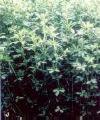Fact or Fiction!
Protein
Too much protein in the diet results in an unmanageable
‘fizzy’ horse and causes allergic skin reactions, laminitis and
tying-up.
I wonder how many of us have heard one or more
of these anecdotes at one time or another.
Protein has received a lot of ‘bad
press’ in the past and there are those who still believe that feeding a
diet which is rich in protein will result in many of the situations above. We
have put together a fact or fiction guide to answer some of the most commonly
asked questions concerning protein.
What is Protein ? Protein is made
up of building blocks called amino acids, analogous to beads in a coloured
necklace, where each coloured bead represents a different type of amino
acid.
Why do horses need protein ? The
amino acids in proteins are needed as raw materials for tissue growth and
repair and for the production of enzymes, hormones and other substances
involved in body metabolism. It is the amount of protein provided daily in
grams which is important and grass, hay and hard feed fed will contribute to
this.
Can I overfeed protein ? All
horses need a certain amount of protein in their diet, which will depend on
their, age, stage of growth and exercise regime. The amino acids produced, from
any protein fed above this requirement, are re-processed. The nitrogen
containing part is excreted in the urine and the other part can either be
converted to fat or used as energy.
Will a protein rich diet make
my horse ‘fizzy’?
In most cases this will depend on the energy
content (MJ / kg) of the ration you are feeding and not the protein content.
The source of the energy may also have some influence, i.e. quick release
energy’ from cereal starch or ‘slow release energy from fibre or oil.
However, you will notice that most feeds that are rich in protein are also
higher in energy. The notable exception to this are alfalfa based feeds, such
as Dengie Alfa-A, which has a protein content of 15% but an energy content of
only 9 MJ/kg. In most cases, the ‘fizz factor’ is as a result of a
miss-match between the amount of energy fed (MJ) and that needed for daily
life, rather than the amount of protein in the diet.
| Feed |
% Protein |
Energy
(MJ/kg) |
| Dengie Alfa A |
15 |
9 |
| Low Energy
Mix |
9.5
|
10 |
| Competition
Mix |
11 |
11.6 |
| Stud Mix |
16 |
12.5 |
| Racehorse
Cubes |
14 |
13 |
| Does too much protein cause laminitis
? |
When laminitis is attributed to
the diet it is more likely to be as the result of over feeding soluble
carbohydrate or sugars, especially in ponies which are overweight. |
| |
|
| Will my horse ‘Tie-up’ if I feed
too much Protein ? |
The current thinking on
‘tying up’ is that excess energy or an imbalance in the body’s
electrolyte and or mineral intake may be implicated. |
| |
|
| Is my horse allergic to Protein? |
Probably not protein per
se. Protein bumps’ or urticaria, when caused by the diet, are probably
the result of a sensitivity to a particular source of protein e.g. barley, oats
or beet pulp. |
So as you can see protein is not always the
‘Bad Guy’ and forms a very important part of our horses diet. But how
much protein should we be feeding ? An average horse in light work will need
about 750g of protein per day. This requirement would easily be met by 8kg of
average quality hay (7% protein) together with a couple of kilos of a course
mix (9-10% protein) or just over a kilo of an alfalfa chaff (15% protein).
The protein requirements of breeding stock and
youngsters, as well as some older horses are higher than that needed for
maintenance and light work. Most stud mixes, foal and yearling feeds and feeds
designed for the veteran horse or pony, usually have a higher inclusion of
protein.
However, as with most other things it is not
just the quantity that is important but also the quality. A quality protein
source will be easily digested and have an amino acid profile similar to that
needed by the horse.
 |
Both Soya and
alfalfa are good sources of quality digestible protein. This all sounds quite
complicated but in fact, most of the hard work has been done for us. Most feed
manufacturers produce feeds designed specifically for different equine
lifestages and take account of their requirements for growth, exercise and even
old age. When fed with good quality forage most of these feeds will more than
adequately cover the protein requirements of all our horses throughout their
lives. |
Dr Catherine Dunnett
Nutritionist

|

